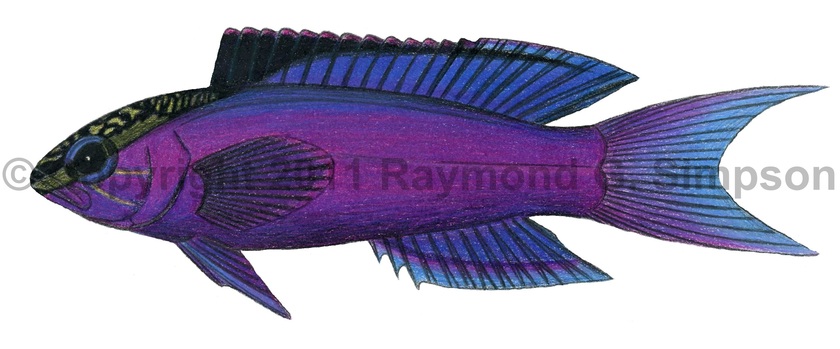
Common Name
Blackcap Basslet
Year Described
Böhlke & Randall, 1963
Identification
Dorsal Fin: XIII-XIV, 8-9
Anal Fin: III, 10
Pectoral Fin: 16-18
Caudal Fin: 12-15 branched, 19-22 segmented
Vertebrae: 10 precaudal, 18 caudal; 28 total
Gill Rakers: 19-23 in lower limb
Elongate with large eye. Pelvic fin rather short, barely reaches anal fin orgin. Lateral line with two parts: the anterior portion on upper body and ending at last dorsal ray and the posterior portion on middle of caudal peduncle reaching anteriorly to middle of soft dorsal. Preopercle serrated. Procurrent caudal rays not thickened. Caudal fin lunate.
Color
Bright magenta, often becoming dark bluish-purple on the dorsal surface posteriorly. A black "cap" with golden spots present from the snout, through the eye, passing onto the dorsal fin, and finishing as a submarginal dorsal stripe. Two golden stripes often run from eye to opercle. Fins usually bright bluish-purple to magenta. Anal fin with dark submarginal stripe. Pelvic fins with dark anterior margin. Upper and lower caudal lobes dark to body-colored.
Size
Maximum size to 10cm.
Habitat
Coral reefs and drop-offs from 10-180m (usually 20-60m). Usually found deeper than G. loreto. Often found in caves swimming upside down. Solitary.
Range
Caribbean Sea from the Bahamas to S. America
References
Hardy, J.D. 2005. Chapter 121: Grammatidae, p. 1341-1351. In: Richards, W.J. (Ed.). Early Stages of Atlantic Fishes: An Identification Guide for the Western Central North Atlantic. CRC Press, Boca Raton, Florida.
Mooi, R.D. 2002. Grammatidae. In: FAO Species Identification Guide to Fishes of the Western Atlantic. (ed. Carpenter K), pp. 1308–1369. UN FAO Publishers, Rome.